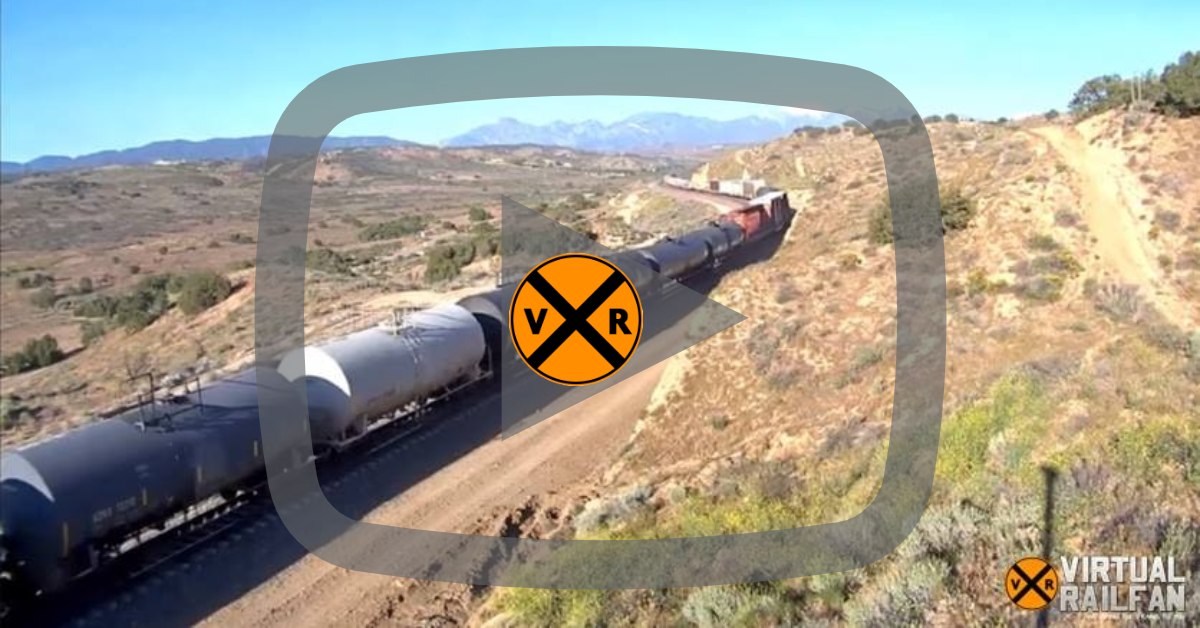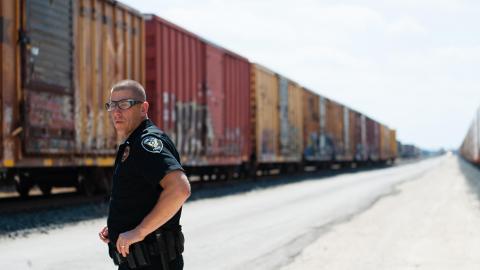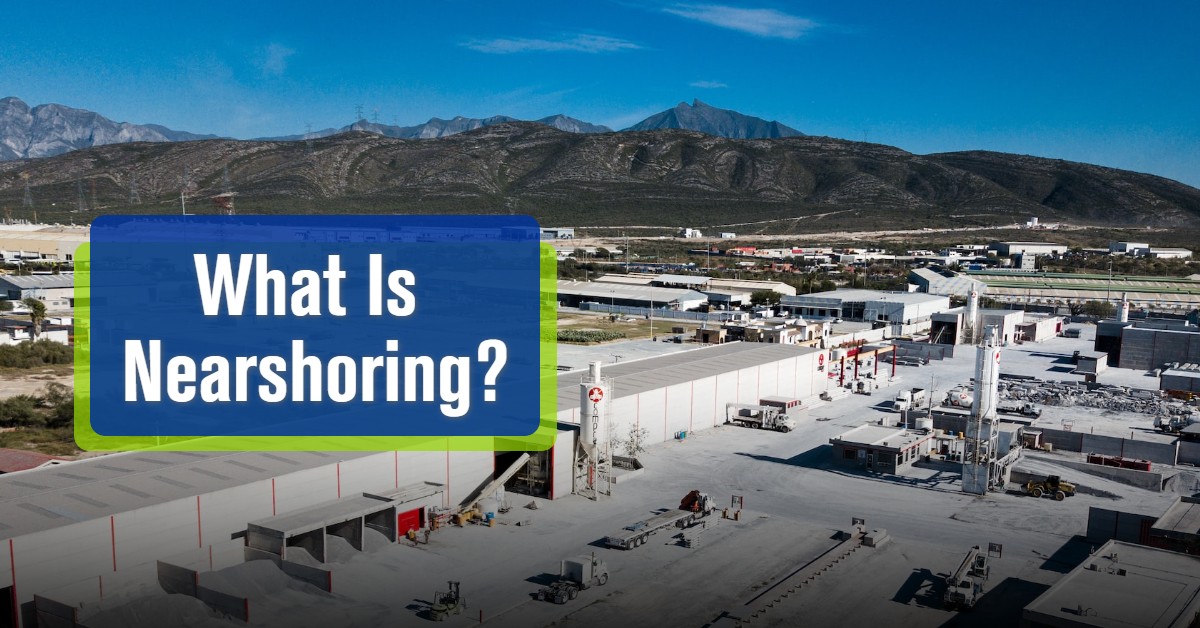Mike Cyr has loved trains since before he could walk or talk — it’s a love that has only grown over the years. As a child, his parents were supportive, but one teacher Cyr remembers didn’t see the use. “No one is ever going to pay you to play with trains,” she told him.
She was wrong.
Today, Cyr is co-owner of a company that builds 3D locomotives and freight cars for a popular train simulator. But he is probably best known for being one of the founders of Virtual Railfan, a hugely popular streaming site and YouTube channel that allows rail fans to watch trains live from the comfort of their own homes.
The Founding of Virtual Railfan
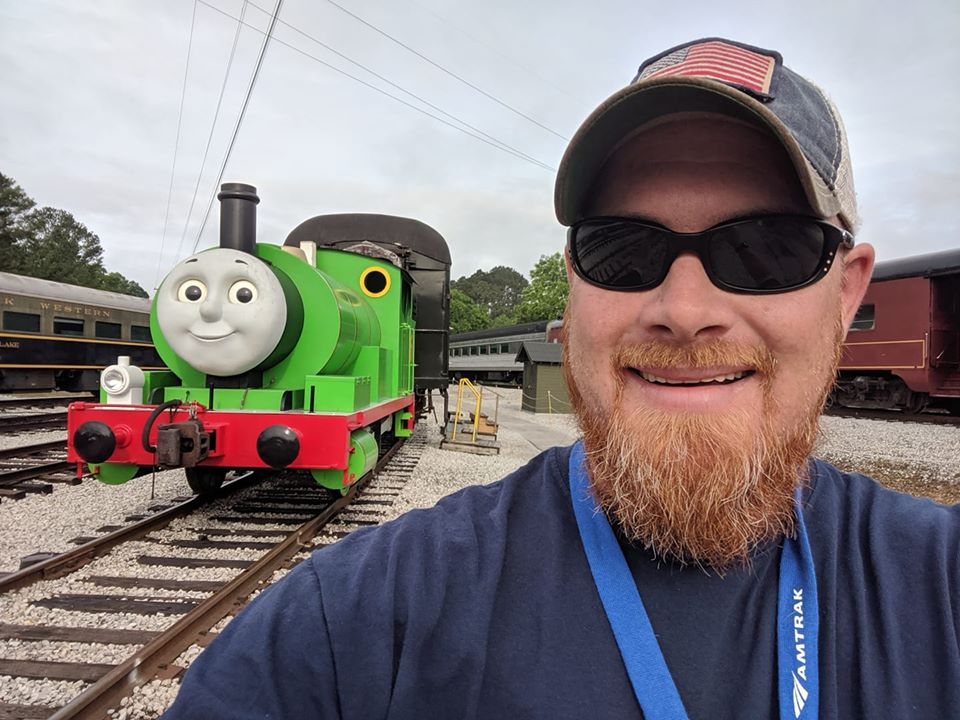
Mike Cyr, one of the founders of Virtual Railfan, at the Tennessee Valley Railroad Museum.
In the town of Folkston, Georgia, a covered platform sits across from a set of railroad tracks. If you didn’t know better, you’d think it was a tiny depot. But it’s actually a spot where rail fans can sit and safely watch trains go by. It was on this platform that the idea for Virtual Railfan was born.
It was early 2010, and Mike Cyr was meeting up with Justin Cornell, now Chief Technology Officer for Virtual Railfan. The two had been working together on the train simulator business from Florida and Louisiana respectively and, as fellow rail fans, had met up several times in Folkston to catch up in person and watch trains. “We were there one night and these two older gentlemen were also sitting there watching trains. And we hear one guy say to the other, ‘Why isn't there one of those webcams so we can watch trains from home?’ I think it was at that moment that the light bulb went off,” Cyr said. “I looked at Justin and said, ‘We could do that, right?’ That’s how it started.”
While it might sound simple, getting the first camera up and running wasn’t easy. Back in 2010, the technology to live stream train footage didn’t really exist, so researching the right equipment was one important first step. And then there was the matter of where to put the camera. “My big thing is quality,” Cyr said. “I wanted all HD video, audio, and a nice unobstructed view looking at the track. I'm thinking obviously Folkston is where we like to watch trains, so let's approach the City and see what they say.”
Cyr started making phone calls and Cornell started researching equipment. Cyr pitched the idea to the City of Folkston. The way he saw it, it was a great promotion for the City — one that would ultimately bring more rail fans to town, which would generate revenue for local hotels, restaurants and more. The City’s answer wasn’t what they expected. It was a no.
That’s when Dixie stepped in.
Dixie McGurn was the former Mayor of Folkston. She just so happened to have a store on Main Street, and she was a believer in Cyr’s vision. She offered to let Cyr and Cornell mount a camera on the roof of her shop, which had a clear view of the railroad tracks. “If you want something done in Folkston, you talk to Dixie,” Cyr said. “I think she will always be the unofficial mayor of Folkston.”
Cyr and Cornell had their location — now to tackle the technology. The first camera cost about $2,000, which, 10 years ago, was a steep price. And then they had to figure out how to stream the footage. Fortunately, they had a friend who owned a hosting company and could help. “The technology really wasn't around, so we kind of had to custom build everything,” Cyr said. “It was pretty much just a camera on a page.”
Adding More Cams…And a Partner
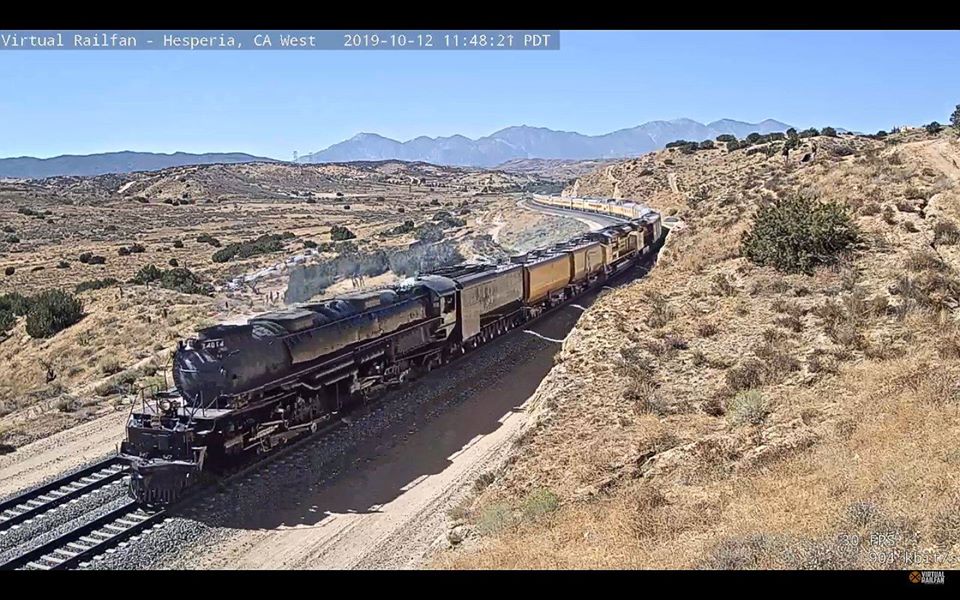
Virtual Railfan's Hesperia camera catches UP No. 4014, aka "The Big Boy," traveling through Cajon Pass in Southern California.
Fast forward to late 2013. Cyr got a call from a man named Mike Tippins. He was one of the original viewers of the Folkston cam, and he had a question: Would Cyr and Cornell want to sell the business?
The pair had always intended to expand Virtual Railfan to make a network of train cameras. But they didn’t have the time or the funding to do so. Tippins shared the vision of creating a network, and he was ready to buy. But Cyr wasn’t ready to sell. “I told him he couldn't write me a check with enough zeros to cover the blood, sweat and tears that we had already invested into this camera and folks in Folkston,” Cyr said. “I said no, I wouldn't be interested in selling at all because now it's a mission and we're going to make it work, maybe not today or tomorrow, but eventually we're going to do it.”
Tippins had another proposition: How about taking on a partner? Cyr told him it had been a money-losing venture so far. Tippins didn’t care. He was in. Tippins is now the Vice President and Treasurer.
With a new partner on board, the team upgraded the Folkston camera and standardized the equipment to be used for future sites. And, as a commercial airline pilot, Tippins had the time and opportunity to scout new sites. He delivered, finding a location in Fort Worth, Texas, that had a clear view of Tower 55, one of the nation's busiest and most congested rail intersections — in other words, a rail fan’s dream. It was a win.
Adding new sites isn’t always easy…or affordable. Internet access can be expensive and difficult to establish. Take one site in Norwalk, Connecticut. A Virtual Railfan viewer suggested they put a camera on an old switch tower. “It’s one of the very, very limited places along the Northeast corridor that you can have a camera that close to the tracks, beyond the wires, and have decent views. So we jumped on it, and we quickly learned that the tower didn't have internet, and it was going to be $53,000 to install it.” Cyr recalls. “At fifty-three grand, we thought that one was dead on arrival.” But then, the Virtual Rail Fan team got creative. They learned a woman in the apartment building next door to the tower had internet, and she was willing to share. Now, for $53 per month, the tower camera is up and running.
In other places, like Cajon Pass, a mountain pass in southern California, it took an investment of about $16,000 to install the camera, as it required trenching through about 700 feet of rock to bring power and internet to where the camera needed to be located. The team forged on, and today it offers stunning views of trains.
The YouTube Debut…and a Viewership Boom
In May of 2017, Virtual Railfan experienced a turning point: An update allowed Virtual Railfan cameras to push a stream directly to YouTube. “That was the gas on the fire,” Cyr said. It didn’t take long for viewership to skyrocket. Today, Virtual Railfan cameras have nearly 10 million viewers per month.
“We've been viewed 221 million times since the cameras launched,” Cyr said in June 2020. “Our viewers have watched about 34 million hours, which translates to almost 4,000 years. And we're now sitting at almost 210,000 subscribers.”
The number of cameras has risen dramatically as well — the site now hosts 81 cameras, 24 of which can be viewed for free on YouTube, with the remaining 57 accessed with a paid subscription. In total, Virtual Railfan has cameras watching 22 different railroads in 50 locations across 25 states and 4 countries. More locations are being added all the time.
Bringing People Together
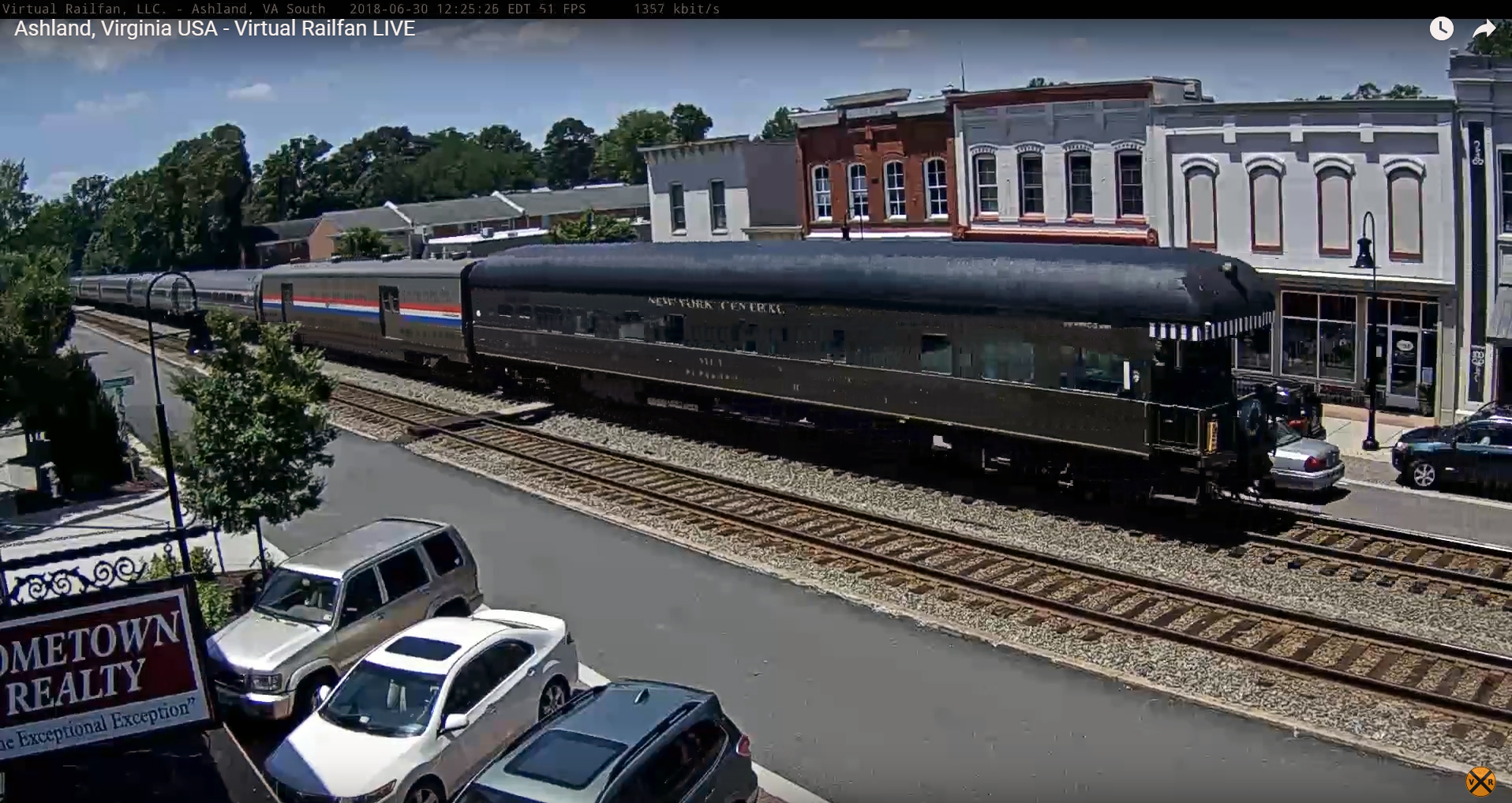
Virtual Railfan's Ashland, Virginia camera.
It’s been 10 years since the idea for Virtual Railfan was born — since then, it’s made more of an impact than Cyr and Cornell could have ever imagined.
Kathy Abbott, who started as a viewer and is now Operations Manager for Virtual Railfan, said the cams offer entertainment for rail fans of all types — those who love locomotives, those who count cars, or those who love seeing the different reporting marks. But for her, it’s always been about the community.
When Abbott moved to Ashland, Virginia, she wasn’t really a fan of trains. But, she found watching the cameras interesting and especially loved the chat rooms. For her, it was social. “There were real friendships being formed amongst the regulars of this live chat,” she said. “And it happens with almost all of our cameras. People really bond, and they look for each other every day.”
The friendships that form often extend beyond the internet. For instance, Ashland has an annual Train Day, and about a dozen people from the chat used it as an excuse to meet up back in 2018. “We actually got to meet each other, and I swear it was like we were longtime friends but just hadn't seen each other forever. These are real friendships,” Abbott said.
In addition to seeing Virtual Railfan bring people together, Abbott has also seen it deliver on Cyr’s original pitch to the City of Folkston. Last year, about 130 people traveled to Ashland for Train Day 2019, having become familiar with Ashland through Virtual Railfan cams. “These people are staying in our hotels. They're eating at our restaurants, they are investing in our economy,” Abbott said. “I always use Ashland as a as a prime example of the marketing value of these cameras. We've had so many of our rail fans who actually plan vacations to basically camera hop and visit their favorite locations.”
Ashland’s train camera has even brought celebrity to an Ashland citizen who often appears on the camera. Leroy, the local crossing guard who is charged with waving busses safely over the tracks, has become hugely popular with viewers. “Our fans live and breathe to see Leroy. They're practically in tears when he leaves for the summer, and they're so excited when he comes back,” Abbott said. “But it's not just watching Leroy. They have sent money to the coffee shop on the corner to get him coffee, or they’ll pitch in for brownies and I'll deliver them to him.”
Leroy isn’t the only beneficiary of viewers’ kindness. When the La Grange, Kentucky, cam showed a railroad crew performing track work for days on end in pouring rain, viewers decided they needed a pick-me-up. So they pooled their money and sent the crew pizza. One woman from England even donated a hundred dollars.
The Virtual Railfan Ripple Effect
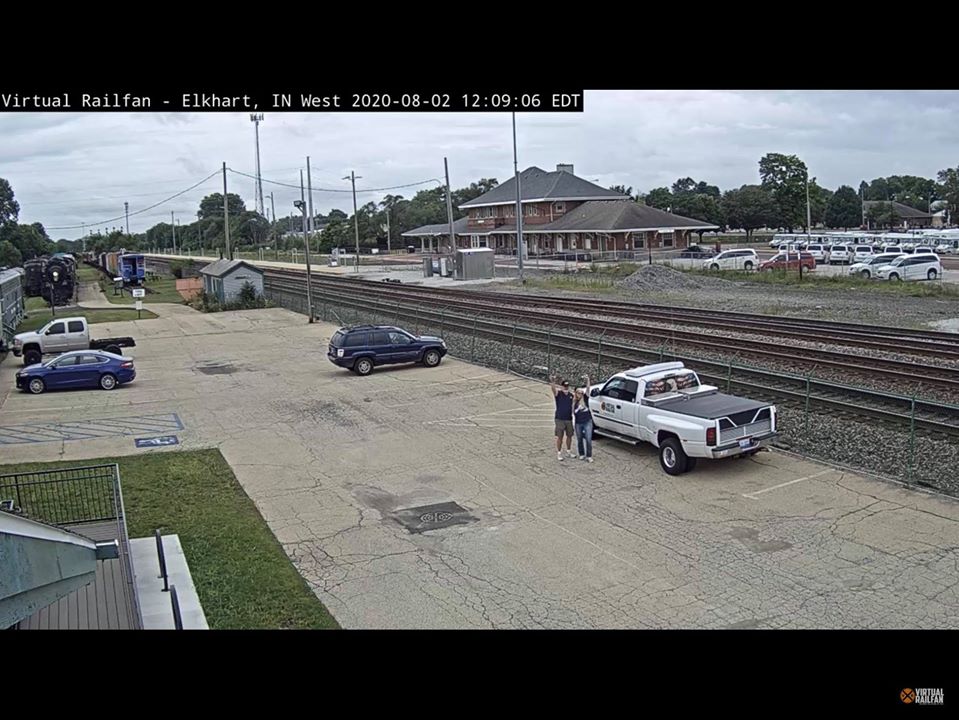
Rail fans wave to the Elkhart, Indiana, rail cam.
The positive effects of Virtual Railfan don’t stop there — they’ve also rippled out in some unexpected ways.
Virtual Railfan footage has actually assisted local law enforcement with investigations. In one instance, some teenagers were trespassing at the Horseshoe Curve National Historic Landmark after hours. But that site in Altoona, Pennsylvania, has a rail camera – and unbeknownst to the teens, about 300 rail fans were watching. When viewers saw them begin to vandalize the site, many called 911. In fact, so many called that they overwhelmed the 911 system, and the dispatch center in Altoona called Cyr to ask him to call off viewers. In addition to alerting authorities, one of the camera operators zoomed in, capturing crystal clear footage of the vandals’ faces and the license plate of their car.
By the time the police arrived, the teens were gone. But the footage wasn’t. Cyr shared it with police, who in turn shared it with a local news channel. Just 25 minutes after it was broadcast, the teens turned themselves in. “You basically have several hundred security guards watching live,” Cyr said. “When something doesn't look right, our viewers are literally the first people that are going to call in to report it.”
Viewers have even saved lives. A few years ago an elderly couple’s car stopped on the tracks in Thomasville, North Carolina. A viewer noticed they hadn’t exited the vehicle — and he knew a train was coming. He immediately called the railroad’s emergency line and the railroad stopped the train less than 200 yards from the vehicle. Had the gentleman called just seconds later, it would have been a tragic outcome for the couple.
And then there are the personal impacts of Virtual Railfan. The site obviously offers rail fans an excellent source of entertainment, allowing them to watch trains all over the country…and in other countries, too. But it also allows homebound rail fans to continue enjoying their hobby. The team has received letters from parents with children on the autism spectrum sharing how much joy Virtual Railfan brings their kids. And it gives people something to look forward to. For instance, one chat room moderator who was embarking on a road trip offered to clean Virtual Rail Fan cameras along his route. Cyr offered to pay for his gas and hotel room, but he declined. His wife had passed away recently and Virtual Railfan was a source of hope. “When we talked he said, ‘This is the best thing that's happened to me.’ It gave him something to do and a purpose,” Cyr said.
Playing with Trains Pays Off
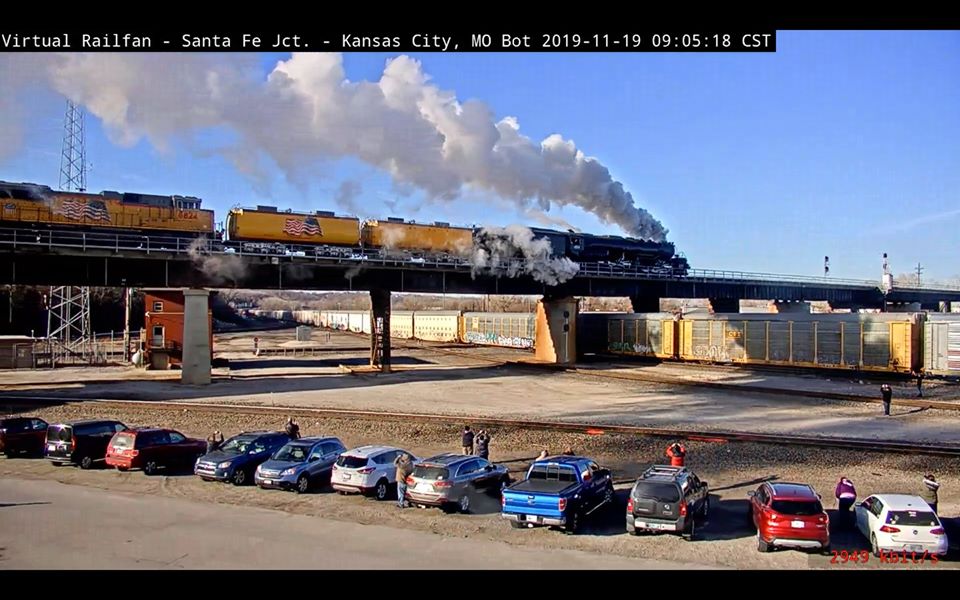
The Santa Fe Junction Virtual Railfan camera catches the Big Boy pass over an auto rack train in Kansas City, Missouri.
Despite his teacher’s doubts about his ability to make money playing with trains, Cyr has been able to do that and so much more with Virtual Railfan. What started as a passion project has resulted in a community of fellow rail fans and a source of hope and joy for viewers. “This place is like Cheers, where you come in and everybody knows your name,” he said. “The most rewarding part is meeting the viewers and the people we’ve made an impact on. Between the viewers and the staff and all the people that volunteer for us, I don't think you could go out and handpick a better group of people. It's some of the best people I've ever worked with in my lifetime.”
So what would Cyr say to that skeptical teacher if she were alive today? “I won this round,” he said.
Learn More
This is the first article in our live train cam series. Don't miss our pieces on Railstream and Tehachapi Live Train Cams, too!
What’s your favorite place to watch trains? Let us know.
Related Articles
- Sitting Trackside with Railstream
- Built by a Community: Tehachapi Live Train Cams
- Stay-at-Home Entertainment for Rail Fans
- The Best Websites for Rail Fans
- Are You a Rail Fan?
- Behind the Scenes with a Rail Photographer: Don Hagen
- 19 Pet Names for Transportation Lovers

